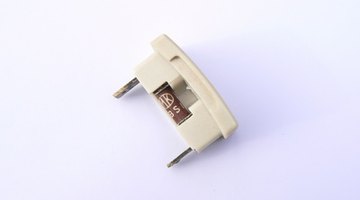How to Make an Electric Fuse
Almost every electrical appliance has a fuse, whether it’s a dishwasher or a low-wattage lamp. They’re an important safety device and protect both you and the electrical device. If a fault develops, the fuse blows and cuts off the electrical supply.

In many instances, when a fuse blows, there isn’t anything wrong with the device; it’s simply that the fuse has gotten worn and needs replacing. If you find yourself in a situation where a fuse has blown and you don’t have any replacements, you can easily make a temporary fuse using multi-ampere fuse wire.
Things You Will Need
- Screwdriver
- Multi-ampere fuse wire
- Ruler
- Knife
- Electrical insulating tape
Tip
Your homemade electric fuse should be used only as a temporary measure. Obtain a replacement fuse as soon as possible. If your homemade electric fuse blows immediately when you turn on the equipment, it means that there’s a fault and you should get the equipment checked out. Don’t try using another homemade fuse.
-
Remove the blown fuse from the electrical device's plug. Unscrew the plug’s cover using a small screwdriver, then pry the fuse out using your fingers or a screwdriver. Check the ampere rating on the side of the fuse. It’s important that you make a temporary electric fuse that has the same amperes. Too high and it can make the equipment dangerous; too low and the fuse will blow again.
-
Measure the length of the fuse using a ruler, then double the measurement. Cut a strip of fuse wire the length of the doubled measurement, using a knife.
-
Place one end of the strip of fuse wire in the center of the blown fuse lengthwise. Wrap the strip of fuse wire around the fuse so it covers the two metal ends of the blown fuse. The fuse wire goes around the fuse but doesn’t quite meet up to the end where you started. If it does, make sure the two ends don’t touch; otherwise, you are doubling the amperes of the electric fuse you are making.
-
Wrap a strip of electrical insulating tape around the center of the blown fuse so it holds the fuse wire neatly in place. Make sure that the metal ends of the blown fuse are exposed and the fuse wire is touching the metal on both ends.
-
Insert the electric fuse into the fuse holder and push it gently into place. Check that the fuse wire is still touching the ends of the fuse. Replace the plug’s cover and tighten the cover using a screwdriver. Insert the plug in the wall socket.
The Drip Cap
- Almost every electrical appliance has a fuse, whether it’s a dishwasher or a low-wattage lamp.
- Remove the blown fuse from the electrical device's plug.
- Wrap the strip of fuse wire around the fuse so it covers the two metal ends of the blown fuse.
- If it does, make sure the two ends don’t touch; otherwise, you are doubling the amperes of the electric fuse you are making.
- Replace the plug’s cover and tighten the cover using a screwdriver.
Resources
Writer Bio
Stephen Benham has been writing since 1999. His current articles appear on various websites. Benham has worked as an insurance research writer for Axco Services, producing reports in many countries. He has been an underwriting member at Lloyd's of London and a director of three companies. Benham has a diploma in business studies from South Essex College, U.K.
Photo Credits
- fuse image by Alison Bowden from Fotolia.com
- fuse image by Alison Bowden from Fotolia.com
More Articles



